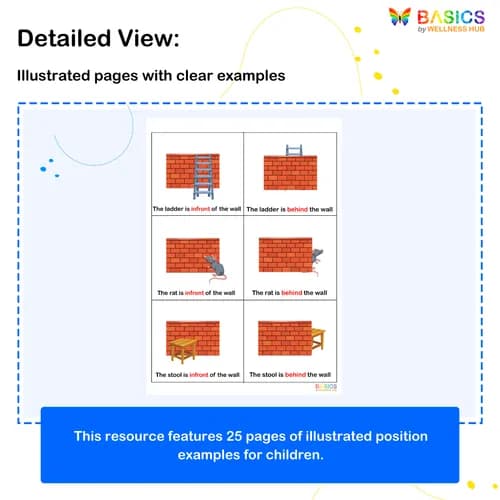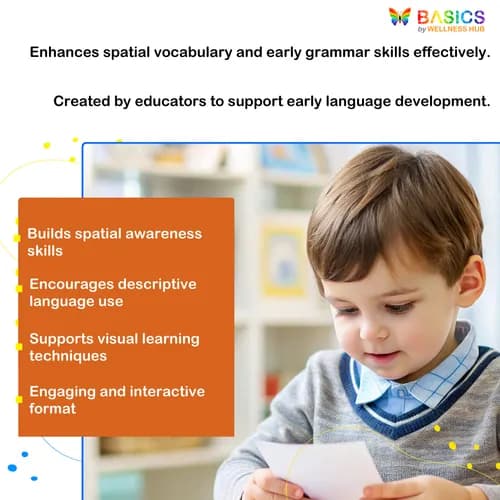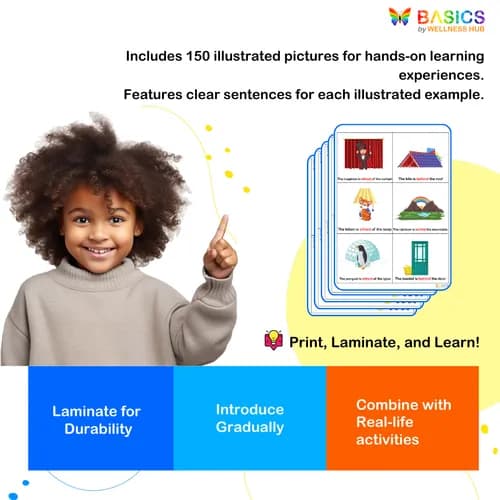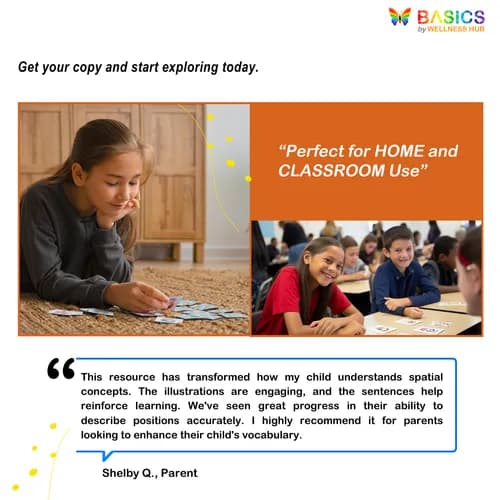





In Front & Behind – Learn Object Position with Visual Examples
₹80
₹160
50% off
0 (0 ratings)
Grade Levels
Pre-K - Grade 2 (Ages 3-7)
Content Overview
Format: Printable PDF, Total Pages: 25, Features: 150 illustrated examples of 'in front' and 'behind' with descriptive sentences.
Categories
Pages from the Resource
Teach children the concepts of 'in front' and 'behind' with this engaging printable PDF. Featuring 150 illustrated examples, each page includes clear visual prompts and descriptive sentences to help kids understand spatial vocabulary and improve their grammar skills. Perfect for early learners and children with special needs.
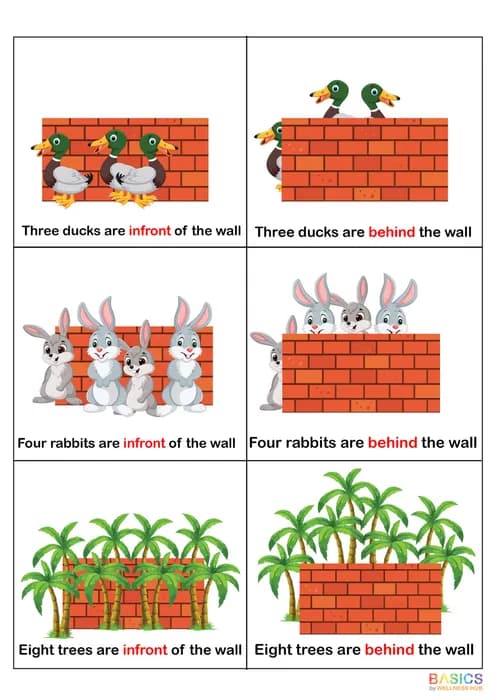
Page 1
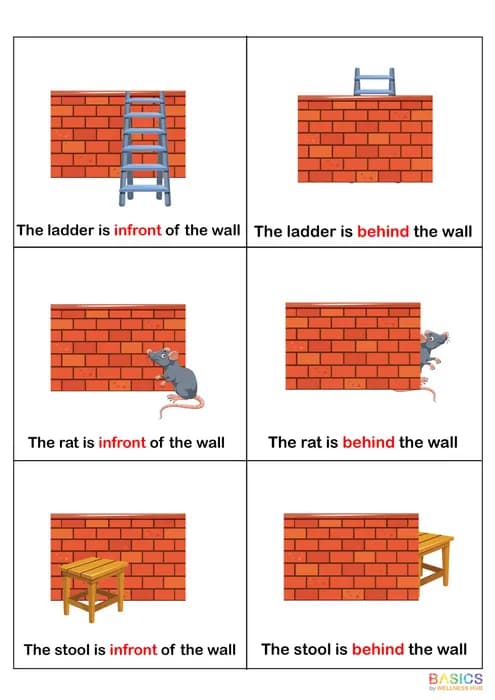
Page 2
What Users Say
0
0 ratings
5
0+
4
0+
3
0+
2
0+
1
0+
5 Stars
Product is Good to use.
1 year ago
Varsha Parent
Similar Products
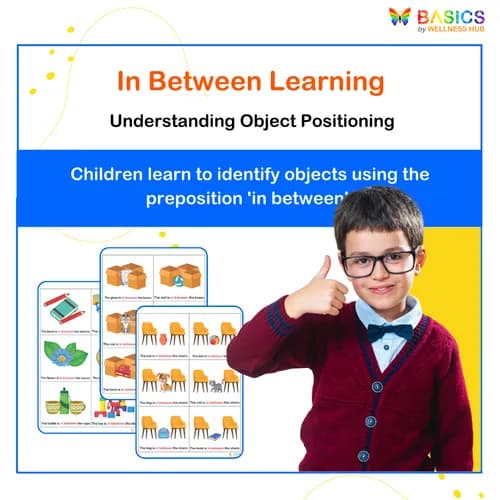
In Between – Learn Object Position with Illustrated Examples
₹ 80.00
₹ 160.00
50% off
4.9 (52 ratings)
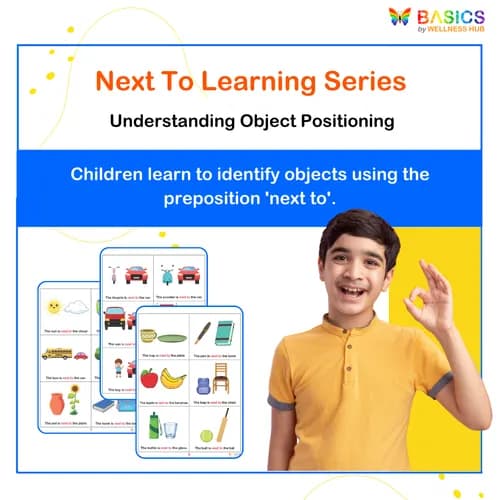
NEXT TO – Learn Object Position with “Next To”
₹ 80.00
₹ 160.00
50% off
4.8 (48 ratings)
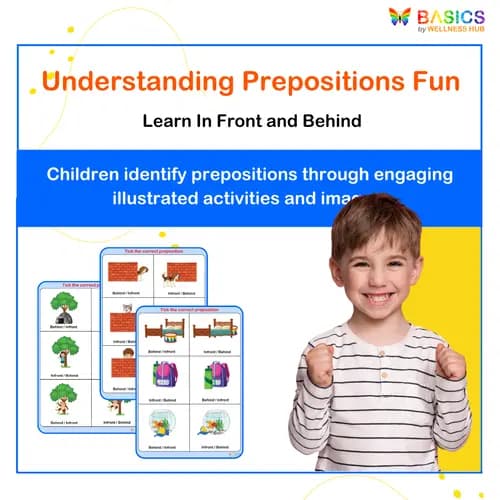
In Front and Behind Prepositions Activity: Printable PDF for Kids
₹ 80.00
₹ 160.00
50% off
4.8 (48 ratings)
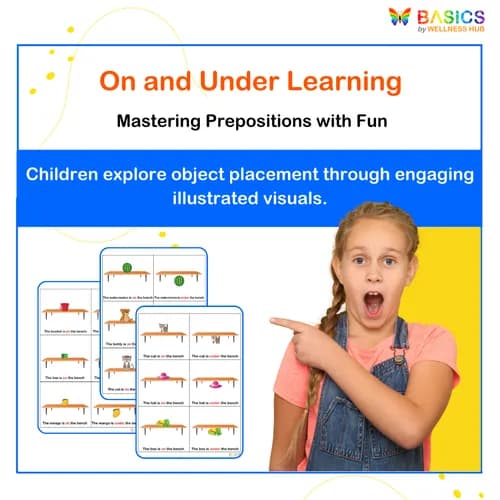
ON & UNDER: Basic Object Position – Printable PDF for Kids
₹ 80.00
₹ 160.00
50% off
4.8 (48 ratings)
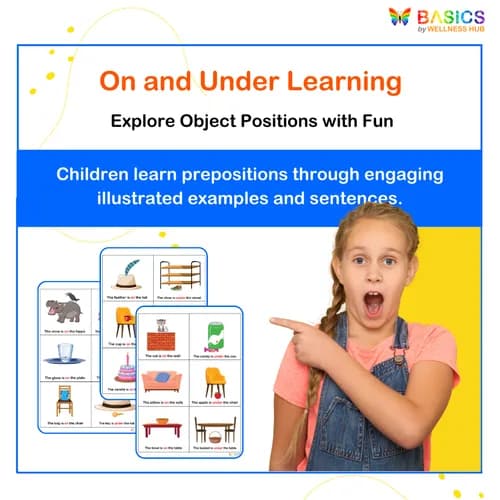
ON & UNDER: Mixed Object Sets – Prepositions Activity for Kids
₹ 80.00
₹ 160.00
50% off
4.9 (52 ratings)
About the Product
Introduction
Understanding spatial relationships is a fundamental skill that helps children navigate their environment and communicate effectively. The IN FRONT & BEHIND – Learn Object Position with "In Front" and "Behind" printable PDF is designed to support children aged 3-7 in mastering these essential prepositions. With 25 pages of engaging illustrations, this resource provides clear visual examples that help young learners grasp the concepts of "in front" and "behind" through relatable scenarios.
Each page features six illustrated pictures that depict various objects, animals, and people in front of or behind other items, accompanied by descriptive sentences. This format not only enhances vocabulary development but also strengthens grammar and observational skills. Ideal for use in classrooms, at home, or in therapy sessions, this resource encourages children to describe their surroundings accurately and boosts their confidence in language use.
Product Details
- Resource Name: IN FRONT & BEHIND – Learn Object Position with "In Front" and "Behind"
- Format: Printable PDF
- Total Pages: 25
- Illustrated Pictures: 150 total (6 pictures per page)
- Content: Mixed examples of "in front" and "behind" on every page
- Example Sentences: Each picture includes a descriptive sentence, such as "The girl is in front of the door" or "The dog is behind the house."
- Designed For: Early childhood education, speech therapy, and language development activities.
Educational Benefits
1. Enhances Spatial Awareness
- Helps children understand the concepts of "in front" and "behind," which are crucial for navigating their environment.
- Encourages them to identify and describe the position of objects and people in relation to one another.
2. Builds Vocabulary and Language Skills
- Expands children's vocabulary by introducing spatial terms in context.
- Promotes sentence structure and grammar as they learn to form complete sentences about object positions.
3. Strengthens Observation and Critical Thinking
- Encourages children to observe details in illustrations, enhancing their attention to visual information.
- Fosters critical thinking as they analyze and compare the positions of objects in various scenarios.
4. Supports Early Literacy Development
- Provides a foundation for reading and comprehension skills through descriptive sentences.
- Encourages children to practice storytelling by describing what they see in the images.
5. Ideal for Diverse Learning Environments
- Versatile resource suitable for classrooms, home learning, and speech therapy sessions.
- Engages children with visual learning, making it accessible for various learning styles and needs.
Instructions for Use
Step 1: Print the PDF
- Download and print the IN FRONT & BEHIND resource on standard A4 or Letter-sized paper.
- Consider laminating the pages for durability and repeated use.
Step 2: Introduce the Concepts
- Begin by explaining the terms "in front" and "behind" to the child using simple language.
- Use everyday examples to illustrate the concepts, such as pointing out items in the room.
Step 3: Explore Each Page
- Go through each page together, discussing the illustrated pictures and reading the descriptive sentences aloud.
- Encourage the child to point out which objects are in front of or behind others.
Step 4: Interactive Learning
- Ask the child to describe what they see in each picture using complete sentences.
- Encourage them to use the target vocabulary by prompting with questions like, "Where is the dog?"
Step 5: Practice with Real-Life Examples
- Take the learning outside or around the house by identifying objects in front of and behind each other.
- Use phrases like, "Can you find something that is in front of the chair?" to reinforce understanding.
Step 6: Reinforce Learning with Games
- Create fun games by asking the child to find objects based on the prepositions learned.
- For example, ask them to place a toy in front of a box or behind a chair and describe their actions.
Step 7: Review and Repeat
- Regularly revisit the pages to reinforce the concepts and vocabulary.
- Encourage the child to teach someone else what they have learned, solidifying their understanding.
Activities Using the Resource
1. Picture Description Relay
Objective: Enhance descriptive language and comprehension of spatial relationships.
How to Play:
- Select a page and show the pictures to the child.
- Ask the child to describe each picture using complete sentences (e.g., "The girl is in front of the door").
- Encourage them to use "in front" and "behind" in their descriptions.
Skill Development:
- Vocabulary expansion
- Sentence structure practice
- Listening and speaking skills
2. Position Scavenger Hunt
Objective: Apply learned concepts to real-life scenarios.
How to Play:
- Create a scavenger hunt by asking the child to find objects in the room that are "in front of" or "behind" other items (e.g., "Find something that is behind the couch").
- Have them describe their findings using the target vocabulary.
Skill Development:
- Spatial awareness
- Critical thinking
- Active engagement
3. Story Creation
Objective: Foster creativity and narrative skills.
How to Play:
- Choose a few pictures from different pages.
- Ask the child to create a short story that includes all the selected pictures, using "in front" and "behind" throughout.
- Encourage them to illustrate their story with drawings or additional pictures.
Skill Development:
- Narrative development
- Imagination and creativity
- Grammar application
4. Matching Game
Objective: Reinforce understanding of spatial terms through play.
How to Play:
- Create pairs of cards with pictures and sentences (e.g., a picture of a dog behind a house and the sentence "The dog is behind the house").
- Shuffle and place them face down; take turns flipping cards to find matches.
- When a match is found, the player must read the sentence aloud.
Skill Development:
- Memory and recall
- Visual recognition
- Sentence fluency
5. Interactive Role Play
Objective: Encourage active learning through movement and role play.
How to Play:
- Set up a small area with objects (toys, furniture) and ask the child to position them according to commands (e.g., "Put the teddy bear in front of the chair").
- Have them describe the positions of the toys using the target vocabulary.
Skill Development:
- Motor skills
- Following directions
- Language application
6. Create Your Own Illustrations
Objective: Encourage creativity while reinforcing spatial concepts.
How to Play:
- Provide blank paper and ask the child to draw scenes that illustrate "in front" and "behind" (e.g., a tree in front of a house).
- Have them write sentences under their drawings to describe the positions.
Skill Development:
- Artistic expression
- Written language skills
- Understanding of spatial vocabulary
Frequently Asked Questions
Q1: What age group is this resource designed for?
A1: The IN FRONT & BEHIND resource is designed for children aged 3 to 7 years. It is suitable for early childhood education settings, including preschool and kindergarten, where children are beginning to learn about spatial relationships and vocabulary. This resource is tailored to engage young learners through colorful illustrations and simple language that resonates with their developmental stage.
Q2: How can I use this resource in a classroom setting?
A2: This resource can be used in various ways, such as during whole-class discussions, small group activities, or individual practice. Teachers can introduce the concepts of "in front" and "behind" using the illustrated pages, encouraging students to describe what they see and engage in interactive learning experiences. Additionally, it can serve as a fun way to incorporate movement by having students physically position themselves in front of or behind objects in the classroom.
Q3: Can this resource be used for children with special needs?
A3: Yes, the IN FRONT & BEHIND resource is designed to be inclusive and can be adapted for children with special needs. The clear visuals and simple sentences make it accessible for various learning styles. Educators can modify activities to suit individual needs, such as using tactile objects or providing additional support during discussions to ensure every child can participate and benefit from the learning experience.
Q4: How many pages does the resource contain, and what is included?
A4: The IN FRONT & BEHIND resource contains a total of 25 pages. Each page features 6 illustrated pictures that depict objects or people in front of or behind other items, accompanied by descriptive sentences. This structure allows for a comprehensive exploration of the concepts, giving children ample opportunities to practice and reinforce their understanding of spatial vocabulary.
Q5: What is your refund policy if I am not satisfied with the resource?
A5: Wellness Hub offers a satisfaction guarantee. If you are not satisfied with your purchase, you can contact our support team within 30 days for a full refund or exchange. We want to ensure that you are happy with the resources you receive, and we are committed to addressing any concerns you may have regarding your purchase.
Q6: How do I access customer support if I have questions about my order?
A6: You can reach our customer support team through the contact form on our website or by emailing us directly. We aim to respond to all inquiries within 24 hours, ensuring you receive the assistance you need promptly. Our support team is knowledgeable and ready to help with any questions or issues related to your order.
Q7: What are the licensing terms for using this resource in a classroom?
A7: The IN FRONT & BEHIND resource comes with a single-user license, which allows you to use it in your classroom for educational purposes. If you are interested in using it for multiple teachers or in a school-wide program, we offer bulk licensing options that provide additional savings and flexibility. Please contact us for more details on bulk purchases.
Q8: How will I receive my digital resource after purchase?
A8: Upon completing your purchase, you will receive an email with a download link to access your digital PDF resource. The download is immediate, allowing you to start using the resource right away. If you encounter any issues with the download, our support team is available to assist you.
Q9: Is there a way to access the resource on multiple devices?
A9: Yes, once you download the IN FRONT & BEHIND resource, you can save it to your preferred cloud storage service, allowing you to access it on multiple devices. This flexibility makes it easy to use the resource at home, in the classroom, or on the go, ensuring you have the materials you need whenever you need them.
Q10: What kind of support does Wellness Hub offer beyond this resource?
A10: Wellness Hub provides a wide range of expert-led therapy and developmental support services for children and families. In addition to resources like the IN FRONT & BEHIND PDF, we offer services such as speech and language therapy, occupational therapy, and behavioral therapy. Our goal is to make high-quality care accessible, and we are committed to supporting caregivers with tools and resources that promote ongoing development and learning.
Usage Rights and Restrictions
Allowed Usage:
- Personal use by parents, teachers, and therapists.
- Printable for classroom, home, or therapy settings.
- Can be used in group or one-on-one learning sessions.
Not Allowed:
- Reselling, redistributing, or modifying the resource for commercial use.
- Sharing publicly (e.g., on blogs, social media, or websites) without permission.
- Uploading the file to public sharing platforms.
If you need a bulk license for schools or therapy centers, please contact us.
Conclusion
The IN FRONT & BEHIND – Learn Object Position with "In Front" and "Behind" printable PDF is an essential resource for young learners aged 3 to 7, designed to enhance their understanding of spatial relationships through engaging visuals and clear language. This 25-page resource not only teaches children the concepts of "in front" and "behind," but also builds their vocabulary, grammar, and observational skills, making it a versatile tool for both home and educational settings.
Ideal for parents, teachers, and therapists, this resource can be seamlessly integrated into daily activities, classroom lessons, or therapy sessions. By using this PDF, you can empower children to accurately describe their surroundings, fostering confidence in their communication skills while making learning fun and interactive. Download your copy today and help children navigate their world with clarity and confidence!
